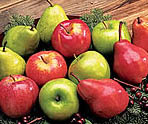There’s a fruit tree for every space and they aren’t difficult to grow. That’s the word in all enthusiastic garden manuals. Sure, they aren’t difficult to grow, but you have to follow some rules to achieve success!
The tree has to suit the climate, the position in the garden and, most importantly, the soil. Healthy soil is imperative for good tree growth and fruit. There’s lots of information pages on soil on the SGA website that will help you get the ground right before you plant.
There are other fruit tree types besides citrus and deciduous, but these are the most popular types of fruit trees planted in the southern states.
People in cooler regions are having success with some tropical fruits too, such as avocados in Melbourne. The rules are the same, except these plants will not tolerate frosts, especially when young. They need to be placed in a warm sunny spot with plenty of summer water.

Citrus
Citrus, which includes lemons, oranges, grapefruit, mandarins, limes and cumquats, do best in warm and mild climate zones. Trees will tolerate some mild frost though.
They like a sunny position. Make sure they get plenty of winter sunshine too by facing them north. Protect them from wind (and they don’t tolerate salt-laden wind).
They don’t like heavy clay soil, doing best in sandy or loam soils. Heavy soils that don’t drain well can lead to root rot problems.
Citrus trees generally have shallow rooting systems, so can dry out rapidly in summer. Mulching to prevent summer soil water loss is a necessity.
Being shallow rooted means roots can be damaged easily by cultivation, so avoid cultivating around them, especially at the dripline (the perimeter of the canopy) as this is where most of the feeder roots are.
They don’t need pruning usually. If growth gets overcrowded some thinning of inward growing stems will open it up. Oranges and grapefruit don’t tolerate severe thinning or pruning. Lemons can be cut back quite well to keep them at a manageable height. Lemons can be espaliered.
Sappy water shoots often grow at the base of lemon and grapefruit trees and these should be cut off. If the tree is a grafted variety, all shoots below the graft need to be removed.
Citrus respond to fertiliser (composted animal manure is ideal) best at the end of winter and then again in late summer. Apply to dripline.
Fruit drop is a common problem and is often due to irregular or uneven watering. Lack of fertiliser or too much can also cause this problem.
Deciduous Fruit Trees
These trees produce fruit in summer, and they lose their leaves and are dormant over winter. Includes apples, pears, plums, peaches, and nectarines.
Because they are dormant in winter they can be grown in areas that have cold winters and severe frosts (late frosts can destroy flower and leaf buds though).
Deciduous fruit trees are often sold as bare-rooted plants during winter, and this is generally the best time to buy and plant. It is possible to plant at any time, but careful watering is essential.

They need plenty of sunshine and will grow in a variety of soil types, although most don’t tolerate very heavy soil.
If planting during winter, don’t add fertiliser until late winter, as the plant is dormant and can’t use the nutrients. Most fruit trees will require yearly applications of fertiliser, applied in late winter. (composted animal manure is ideal)
Most deciduous trees are pruned to a vase shape (although many can be espaliered) and are pruned in winter. Pruning is usually hard for the first few years to develop a good shape. Later pruning is to remove dead wood, ingrowing branches, thin overcrowding branches, or to cut back leaders or main limbs.
Each kind of tree has its own habit of growth, and some require two trees (a male and female) in order to produce fruit. Get more information on specific trees from your garden centre or from gardening books (the local library is a brilliant resource).
Fruit trees can be susceptible to a wide range of pests and diseases. For more information on pest and disease control, refer to What Garden Pest or Disease is That?, by Judy McMaugh, (published by New Holland). Remember though, keep the tree healthy and that’s half the battle.
Reference: Yates Garden Guide, published by Harper Collins
Related Articles:
Garden Journaling – Slow down to tune in.
As we move through the year and our gardens evolve, there's something magical about documenting the journey. Garden journaling is an art that enables…
The Importance of building soil health for a biodeverse, productive garden
Creating a thriving garden that not only sustains itself but also contributes to the broader ecosystem requires more than just sunlight and water.…


